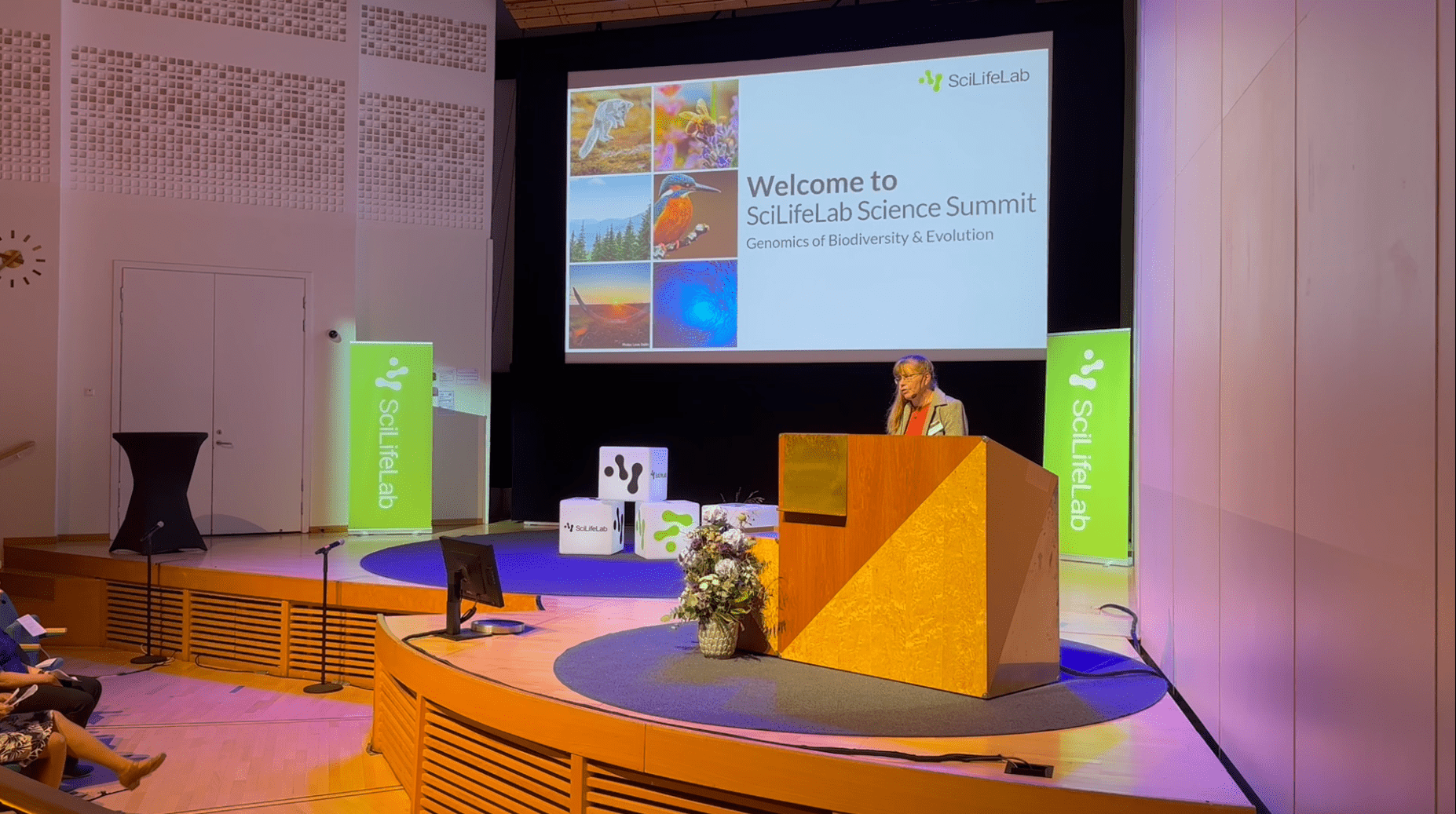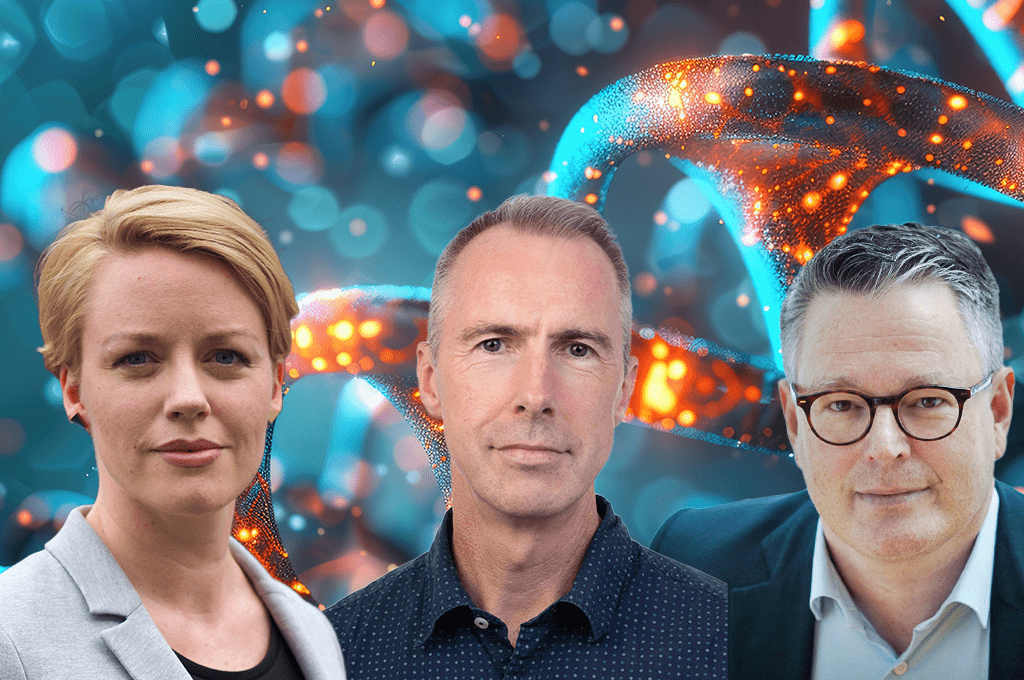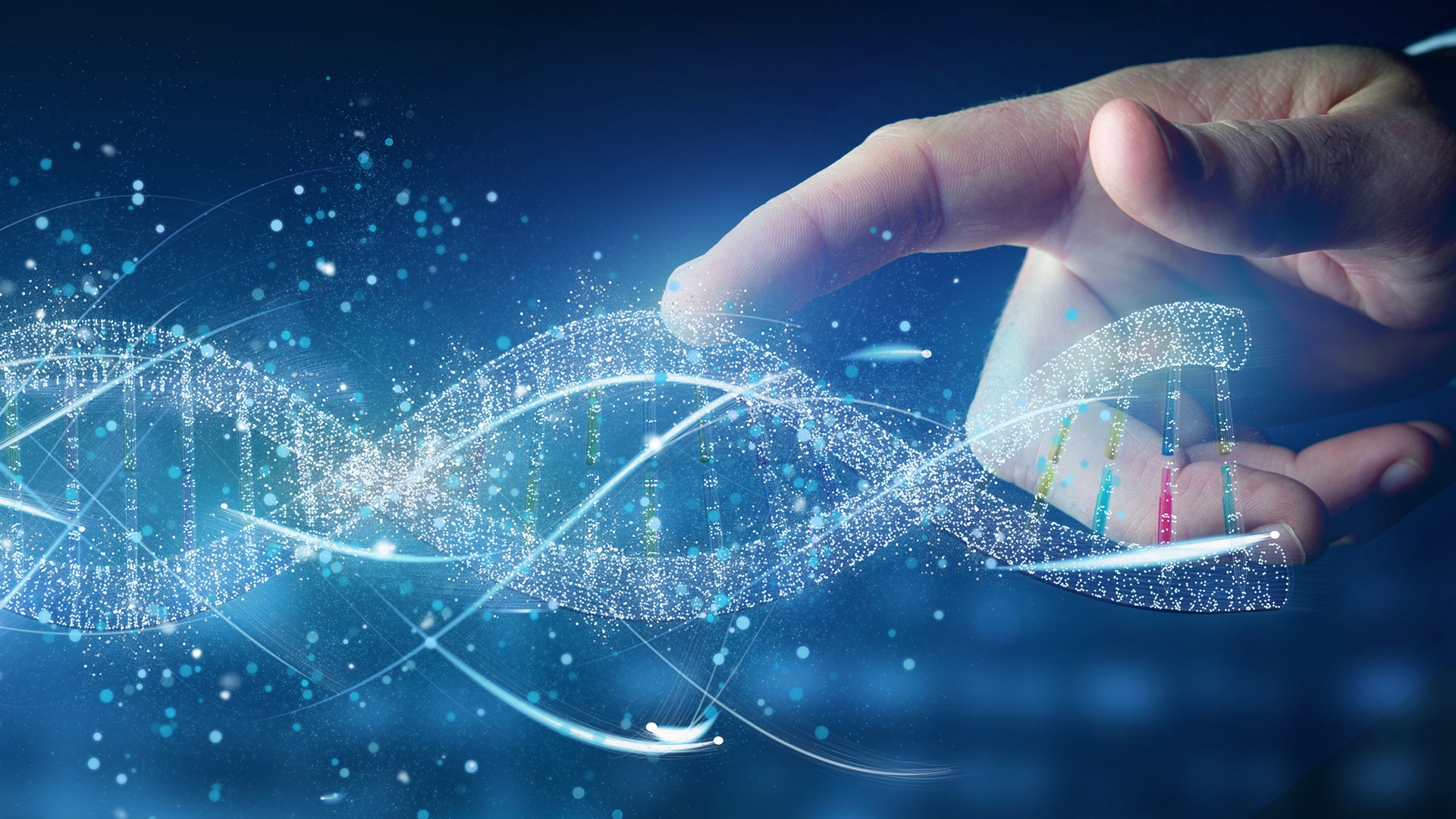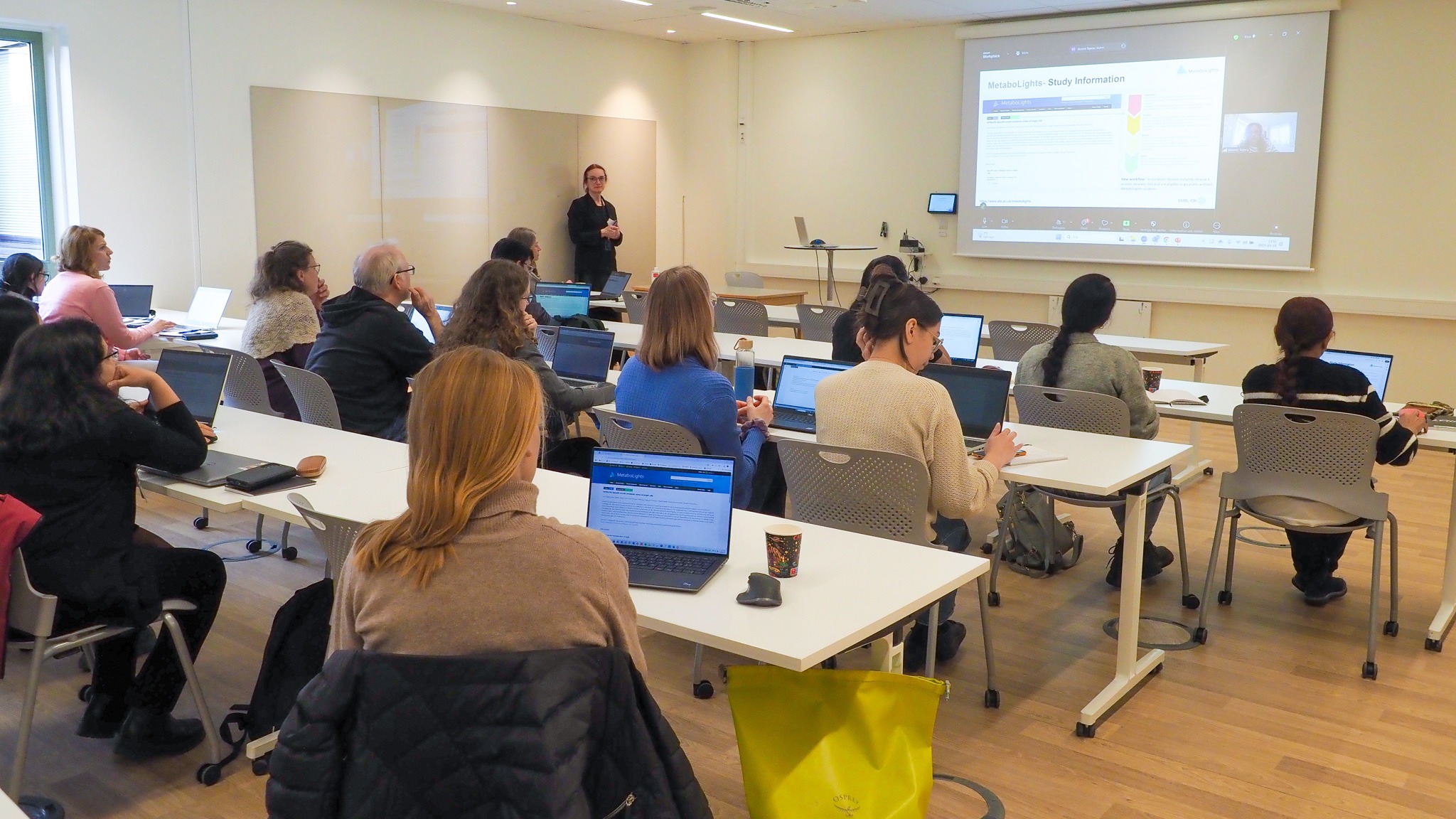SciLifeLab Science Summit 2023: a Celebration of Genomics, Biodiversity and Evolution
September 20, 2023 – For the first time since 2019, the SciLifeLab Science Summit took place at the Aula Magna venue in Stockholm, with over 300 researchers, academics, and industry professionals in attendance. The SciLifeLab Science Summit, focusing on the theme “Genomics of Biodiversity and Evolution,” brought together a rich tapestry of scientific insights and breakthroughs in genomics. The day included talks from leading experts within the field, flash talks about cutting edge research and a show floor filled with posters and discussions.
Professor Ylva Engström, SciLifeLab Chair of the Board, opened the day, expressing her delight at seeing such an impressive turnout. She emphasized the potential for new research collaborations and underlined the importance of fostering a platform where scientists can share, debate, and further their work.
Chair of the Scientific Committee, Kerstin Lindblad-Toh, set the day in motion by offering a synopsis of what attendees could expect. Highlighting the extensive range of topics covered and the expertise of the attending speakers.
“In addition to having the competence of technology, you also really want to have a research community […] And that really shows when you see today’s talks: the different ages of people, the different backgrounds, and more than 300 people mingling on such an important topic as genome biodiversity,” says Kerstin Lindblad-Toh, Chair of the Scientific Committee, co-founder of SciLifeLab and Professor at Uppsala University.
The speaker talks spanned a range of topics in genomics, adaptation, and evolution, each contributing a unique perspective to the overarching theme.
The speakers for the SciLifeLab Science Summit 2023 and a brief summary of their talks:
- Elinor Karlsson, University of Massachusetts Medical School & Broad Institute: Investigating mammalian evolution and human disease through comparative genomics in hundreds of species
The Zoonomia project, analyzing 240 placental mammal species, identified exceptionally conserved genome bases crucial for function, with 80% of the most constrained bases lying outside protein-coding exons. This comparative genomics approach, delving into the genomic foundation of diverse phenotypes that have evolved over 100 million years, pinpoints elements associated with unique traits like olfaction and brain size and is paving the way for future biotechnological breakthroughs. - Tom van der Valk, Swedish Museum of Natural History: A Million-Year-Old Journey: Exploring Mammoth Speciation and Adaptive Evolution through time
Using genome-wide data from woolly mammoths, researchers have unearthed insights into evolutionary processes, identifying a previously unknown mammoth lineage, evidence of inter-species hybridization, and protein-coding changes linked to cold adaptation present a million years ago. - Richard Durbin, University of Cambridge: Insights from high quality genome sequencing across the tree of life
The use of high-accuracy PacBio CCS reads, and Illumina Hi-C data has facilitated the creation of over a thousand high-quality, chromosomal genome assemblies at reduced costs in the Tree of Life program at the Wellcome Sanger Institute; this progress allows for the characterization of rapidly evolving centromere-associated repeats and the detection of previously unnoticed somatic mutation signatures across various species. - Karin Norén, Stockholm University: Conservation genomics of the Scandinavian Arctic fox
Whole genome sequencing of over 80 Arctic fox genomes has unveiled insights into inbreeding dynamics, deleterious genetic variation, and short-term genetic rescue effects, particularly revealing the consequences of an immigration event and the linkage between genetic variation and individual fitness, providing essential data for informed conservation decisions for small and threatened populations. - Tom Gilbert, University of Copenhagen: Domestication hologenomics – what are we missing without taking this approach?
Comparative genomic analyses between contemporary domesticated species and their wild counterparts reveal insights into the origins and key genetic variants of modern phenotypes; when paired with palaeogenomic data, the sequence of variant emergence can also be discerned, but the role of the hologenome in domestication might have been underestimated. - Tanja Slotte, Stockholm University: Sequencing the supergene that governs Darwin’s different forms of flowers
The assembled high-quality genomes of various Linum species provide insights into the S-locus supergene governing the floral polymorphism of distyly, revealing its unique genetic architecture and elucidating the evolution and structure of supergenes described by Darwin. - Leif Andersson, Uppsala University: The remarkable population structure of Atlantic and Baltic herring – selection, selection, selection
While initial genetic studies indicated no differentiation among Atlantic herring populations, whole genome sequencing has revealed numerous ecotypes with adaptive variations, highlighting strong genetic differentiation at selected loci but minimal at neutral ones, attributed to large population sizes, effective selection, and gene flow. - Karin Rengefors, Lund University: Why cyanobacterial blooms produce toxins – unravelling the underlying genetic diversity in the microcystin gene cluster
Cyanobacterial blooms, especially the Microcystis genus, are harmful due to the production of the toxic microcystin, whose function in cyanobacteria remains unclear. While toxigenic strains are often identified using quantitative PCR targeting genes like mcyB or E, this doesn’t always correlate with waterborne microcystin levels.
“I think the Science Summit is fantastic because it’s showcasing a real range of diverse areas that genomics is applied to today, from ecology and evolution,” says Professor Tom Gilbert, University of Copenhagen.
Between the talks, you could overhear buzzing talk from the attendants, discussing what they had just heard and wanting to learn more about specific topics or discuss their own research from a new perspective.
The SciLifeLab Science Summit also showcased four flash talks from the most impressive abstracts that were selected to provide brief (5-minute talks) yet impactful presentations about their ongoing research:
- Cynthia Perez Estrada, Karolinska Institutet: Three-dimensional genome architecture persists in a 52,000-year-old woolly mammoth skin sample
- Patrik Rödin Mörch, Uppsala University: The Role of Population History in Shaping the Mutational Load of Structural Variants Relative to SNPs, in Distinct Island versus Continental Lagopus Lineages
- Andreas Wallberg, Uppsala University: New insights into the evolutionary history and adaptive potential of World Ocean krill using comparative population transcriptomics
- Qiaoling Deng, Uppsala University: Genetic parallelism and adaptation to brackish water bodies in sprat (Sprattus sprattus) and Atlantic herring (Clupea harengus)
The SciLifeLab Science Summit show floor was another hive of activity, filled with research posters and industry booths. Attendees had the chance to delve deeper into varied scientific subjects, explore industry advancements, and discuss the theme of the day.
The show floor included the SciLifeLab corner, giving attendants new and broader insights into the work of SciLifeLab. The booth also showed interviews with researchers and fellows within SciLifeLab and gave new and updated details about the large project “Data-Driven Life Science”, supported by the Knut and Alice Wallenberg Foundation (KAW).
“I think the DDLS, the data-driven life sciences initiative here in Sweden, is actually very impressive in helping support young people at early career stages,” says Professor Richard Durbin, University of Cambridge.
At the end of the day, the Science Summit 2023 Best Poster award was presented to Cynthia Perez Estrada of SciLifeLab and Karolinska Institutet (KI). Her exemplary work on the three-dimensional genome architecture found in a 52,000-year-old woolly mammoth skin sample stood out, underscoring the innovations in genomics research.
“So this kind of event brings people together. Not just the senior scientists, the ones that everybody sort of think of as being the important ones, but also the junior scientists and the students, graduate students and trainees. That’s really important because they’re the ones that are actually coming up with some of the newest research,” says Professor Elinor Karlsson, University of Massachusetts Medical School & Broad Institute.
In wrapping up, the SciLIfeLab Science Summit not only showcased cutting-edge research but also reinforced the essence of collaboration and knowledge exchange.





